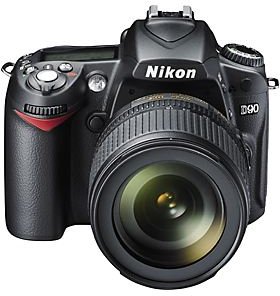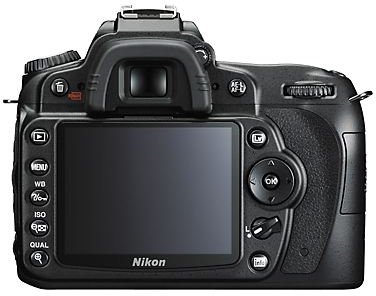Nikon D90 Camera Review
Overview and Specifications (5 out of 5)

The Nikon D90 DSLR has a 12.3 megapixels APS-C sensor, that has a built-in cleaner. The D90 is compliant with SD or SDHC memory card, it can shoot at 4.5 frames per second, and was the world’s first DSLR to include a High Definition video recording mode. It has an 11 point autofocus system, live view capabilities, and a high resolution, 3-inch LCD screen. The D90 includes in-camera editing, active D-lighting to balance shadows and highlights, and a shutter that is tested to 100,000 shots, and beyond. Unlike lesser cameras in the Nikon range, it will also autofocus with all Nikon AF lenses, due to its built in focus motor. So, although specifications like this are bettered by Nikon’s pro-level cameras, there is still plenty on offer here to satisfy even the most demanding photographers.
Features (4 out of 5)
HD Video Mode
When the D90 was launched, the headline feature on the spec page was the High Definition movie ability. Although this has since been replicated in other cameras, the D90 was the first camera to have it. In practice it works well, but is not without its drawbacks. Press the Live View button, and then the ‘OK’ button to start recording. The D90 records at 720p and 24 fps which is good, but not quite as smooth as the 30 or even 60fp fps you will find in many point and shoot cameras these days. The much publicized flaw you may encounter is known as the jello effect. You experience a wobble or ‘jello’ effect in your videos when you quickly pan horizontally while shooting a movie. Also worth noting is that the D-movie mode is manual focus only on the D90, regardless of what lens you have on. However, all that aside, you can get great results with some practice. Check out the D90 channel on Vimeo for some great examples of what can be done.
In-Camera Editing
The 3-inch LCD is great for reviewing images, and even doing some in-camera editing. There are a whole variety of effects you can add to your photos, like red eye correction, fisheye effects, distortion correction, black and white conversions, various filter effects, picture straightening, and an in-camera RAW to JPEG conversion facility. Although I do many of these things in Photoshop, it is often good to see what it would look like before you get back to your computer. The D90 saves the retouched photos as separate files, so you will always have your original to go back to.
Active D-Lighting
Nikon’s Active D-Lighting is a feature originally borrowed from the D3, and D300. It helps ensure your highlights are not too bright, and your shadows still have detail. You can apply D-Lighting in a variety of strengths, turn it off altogether, or just leave it on auto to let the camera pick the best settings. I have mine on auto, and almost always get the results I want.
Design (5 out of 5)

The Nikon D90 DSLR is a great fit for your hands. The grip is comfortable and reassuring. There is a control wheel at the back of the camera where your thumb rests, and also one at the front for your index finger. The body is bigger than the D3000 and the D3100, but not so big that you will have trouble reaching the controls. The main settings can all be accessed without diving into menus on the LCD screen, as they almost all have buttons of their own. If you have used Nikon DSLRs before, you will definitely feel at home with the layout and design of the D90.
Performance (5 out of 5)
The Nikon D90 is ready the second you turn it on, and can quickly churn out 4.5 JPEGS every second on its continuous shooting mode. Shutter lag, like most DSLRs, is so small that you would have to have professional equipment to even begin to measure it! So, you will rarely miss that fleeting expression, walking toddler, or shot on goal. The 11 point autofocus system is quick, and accurate. It can be set for auto, single point, dynamic area, or a new 3D tracking mode. All perform as you would expect in the situations they are designed for. Digital noise is well controlled up to ISO 3200, and that makes this a great camera for low light situations. CIPA rate the battery as good for 850 shots when fully charged, so you can easily go weeks between charges under light to normal use.
Price to Value (4 out of 5)
At the time of writing this review, the D90 body can be bought for around $795, and the D90 with the 18-105mm kit lens is just over $1000, so you are getting a lot of camera for your money. It is packed full of features and may very well be the last camera you ever need. Ironically, however, the biggest competition for your money might be another Nikon camera - the D5000. The reason for this is that the D5000 offers many of the same features as the D90, but for less money. A D5000 can be bought for about $675, and that includes the 18-55mm kit lens. So, what are the differences? With the D5000 you don’t get the high resolution LCD screen, the built in focus motor that will work on all Nikon AF lenses, the larger pentaprism viewfinder, the tougher body, or the top mounted LCD screen. If those things are important to you, then get the D90. You won’t regret it.